To tailor a vintage silk scarf, start by selecting a scarf in good condition and a size that fits your vision, like a 20 x 20 inch neckerchief for versatile styling. Gather sharp scissors, a sewing machine with a size 10 needle, and fine pins for precision. Lay the scarf flat, mark cutting lines with tailor's chalk, and cut with care. For hems, try a fold-over finish for simplicity or a hand-rolled hem for elegance. Finally, experiment with how you style it—knot it around your neck or bag. Keep exploring for creative uses that breathe new life into your scarf!
Selecting the Right Fabric
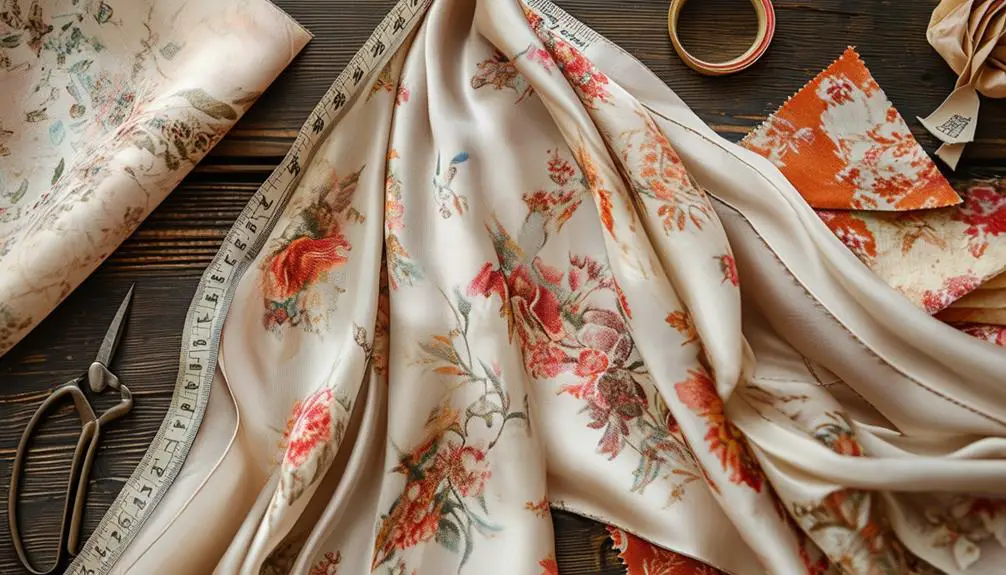
When you're on the hunt for the perfect vintage silk scarf to tailor, the fabric choice is vital. Opt for lightweight fabrics like habotai or chiffon, which drape beautifully and are easier to work with. These materials lend themselves well to various tailoring projects, allowing for creative expression while maintaining the scarf's elegance.
Additionally, researching vintage clothing trends by era can help you identify scarves that reflect unique styles from different decades. As you sift through those charming vintage scarves, make certain to choose ones in good condition. Avoid any with frayed edges or significant wear, as these flaws can complicate the tailoring process.
Remember, the size matters too! Standard vintage silk scarves usually range from 20 x 20 inches to 36 x 36 inches, offering ample fabric for your designs.
Don't forget to take into account the pattern and color of the silk scarf. Bold prints can infuse a unique flair into your tailored piece, while solid colors provide versatility for any wardrobe.
Understanding Scarf Sizes
Understanding scarf sizes is essential for achieving the perfect look and function with your vintage silk scarf.
When it comes to silk scarves, the dimensions can greatly influence how you style them. Here are some common sizes to take into account:
- Neckerchief: About 20 x 20 inches (50 x 50 cm), perfect for a chic neck tie or headband.
- Head scarf: Larger at 60 inches (150 cm) on each side, offering ample fabric for various wrapping techniques.
- Shawl: Generally around 55 x 55 inches (140 x 140 cm), providing both warmth and style.
Tools and Preparation

Gathering the right tools and preparing your workspace is essential for successfully tailoring a vintage silk scarf. Start by gathering sharp scissors, a sewing machine fitted with a size 10 needle, and extra fine pins. These tools guarantee you handle the delicate silk fabric with precision. You'll also need white tailor's chalk for marking adjustments, as it's easy to remove and won't stain the fabric.
Before diving in, prepare a spacious workspace to lay out the scarf without any creases. Secure the edges with weights or pins to prevent slipping while you work. Don't forget to pre-wash the scarf to avoid color bleeding and shrinkage later on. This step allows the fabric to settle, making your tailoring more accurate.
Lastly, have suitable thread on hand, like silk sewing thread or polyester, to match the scarf's weight and texture for a seamless finish.
Here's a quick reference table for your tools:
| Tool | Purpose | Notes |
|---|---|---|
| Sharp scissors | Cut excess fabric | Must be sharp for precision |
| Sewing machine | Sew the scarf together | Use size 10 needle |
| Extra fine pins | Secure fabric while working | Prevents slipping |
| Tailor's chalk | Mark adjustments | Easy to remove |
| Suitable thread | guarantee a seamless finish | Match the fabric's texture |
Cutting Techniques
With your tools ready and workspace prepared, it's time to focus on cutting the vintage silk scarf. Precision is key in this process, so follow these cutting techniques to guarantee a beautiful finished product.
- Always add a half inch (1.5 cm) seam allowance on each side. This extra fabric prevents fraying and allows for a clean, rolled edge.
- Lay the scarf flat on a large, clean surface. This setup provides ample space and helps avoid any damage to the delicate silk.
- Use extra fine pins to secure the fabric in place; silk can easily shift, leading to uneven cuts.
Before you begin cutting, mark your cutting lines with white tailor's chalk or chalk pens. Avoid colored chalk, as it may leave permanent marks on the fabric.
For the actual cutting, employ sharp scissors or a rotary cutter for precision. Blunt tools can damage the delicate fibers, ruining your scarf.
Hemming Methods
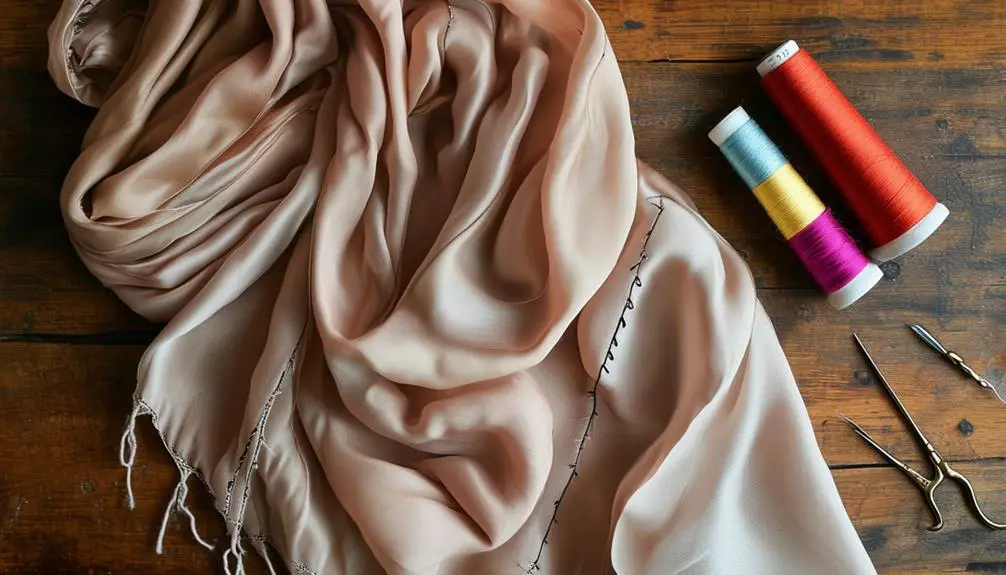
When you plunge into hemming your vintage silk scarf, you'll discover various techniques that can elevate its appearance and durability.
One of the simplest methods is the Fold-Over Hem, where you create a half-inch fold along the edge of the fabric and sew it down, giving you a neat finish—great for beginners!
If you're aiming for a more professional look, try the Hem with Mitered Corner. This technique involves folding the corners at a 45-degree angle, ideal for sturdier silk fabrics.
For sheer materials, the Narrow Hem is perfect. You'll fold in the edges twice, typically 1/8 inch each time, and press, resulting in a delicate finish.
If you want to add an elegant touch, the Hand-Rolled Hem is a traditional choice. This method involves rolling the edge of the fabric and stitching it by hand, creating a refined look for lightweight silks.
Styling Your Scarf
Silk scarves are incredibly versatile accessories that can instantly elevate your look. Whether you're dressing up for a formal event or going casual, these scarves can add a great edge to any outfit.
Here are a few stylish ways to wear your vintage silk scarf:
- Tie it around your neck for a classic, chic vibe.
- Use it as a headband to give your hairstyle a fresh twist.
- Knot it on the strap of your handbag for an eye-catching detail.
When styling your scarf, don't shy away from bold colors and patterns that complement your outfit. Vibrant designs can serve as statement pieces, drawing attention and admiration.
Experiment with different knots and folds, like the classic loop or the French twist, to create a polished appearance that suits your personality.
Layering your silk scarf over a light jacket or sweater not only adds texture but also enhances the overall dimension of your look.
With just a bit of creativity, you'll find that the right scarf can be the perfect accessory to bridge casual and formal styles effortlessly. Embrace the art of styling and let your vintage silk scarf shine!
Creative Uses for Scarves
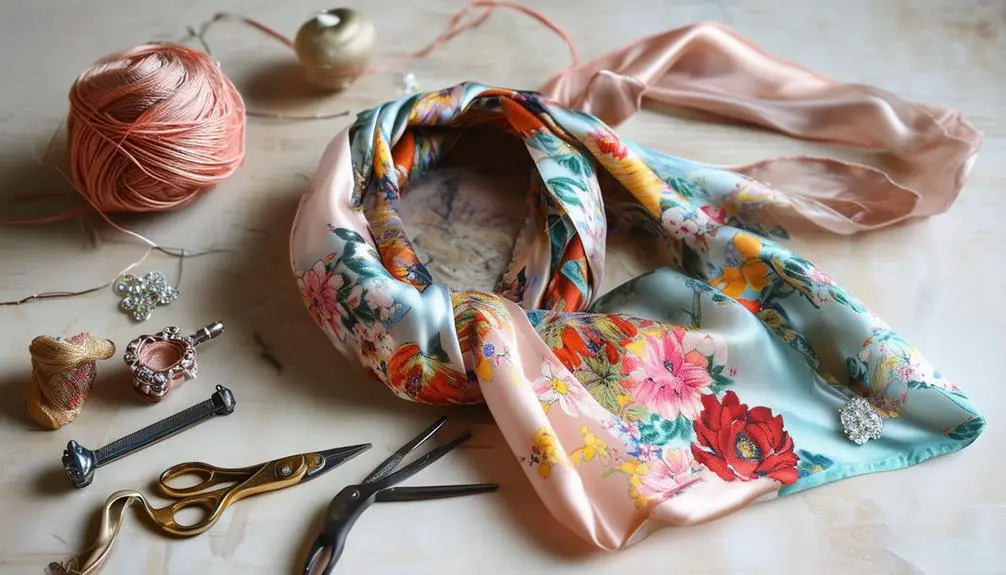
Scarves aren't just for styling; they can also spark your creativity in unexpected ways. Vintage silk scarves, with their vibrant patterns and delicate fabric, can be transformed into unique blouses or tops. By sewing them together and using a bit of fusible interfacing for added stability, you can create a stylish, lightweight piece perfect for summer outings.
Furthermore, understanding the history and value of these scarves through vintage tag identification can add a layer of appreciation to your creative projects.
You can also repurpose these scarves into handbags or pouches, allowing you to express your creativity while crafting functional accessories. Imagine a chic handbag made from your favorite silk scarf, turning heads wherever you go.
Additionally, incorporating vintage silk scarves into patchwork projects can add texture and visual interest to skirts or decorative pillows, making your home feel uniquely yours.
Want a stylish way to wrap gifts? Try using a scarf! Inspired by the Japanese furoshiki technique, it offers a reusable and elegant alternative to traditional wrapping methods.
Upcycling Vintage Scarves
Upcycling vintage scarves opens a world of creative possibilities, allowing you to transform forgotten treasures into stylish, modern pieces. With their vibrant patterns and luxurious feel, these oddly shaped silk beauties can be reimagined in countless ways. You can create unique fashion items or decorative home accessories that not only look good but also promote sustainability.
Exploring the history of brands like Betty Barclay enhances your understanding of the styles and craftsmanship that vintage scarves may embody.
Here are a few ideas to spark your creativity:
- Patchwork designs: Combine multiple scarves to form eye-catching garments or bags, showcasing a variety of colors and patterns.
- Layered summer pieces: Use the lightweight nature of silk to craft elegant tops or skirts that are perfect for warm weather.
- Home decor: Repurpose scarves into throw pillows or wall art, adding character and charm to your living space.
Pay attention to stitch length when sewing your pieces; shorter stitches can enhance durability and texture. Techniques like rolled hems or scrunching can elevate your designs, transforming each piece into a conversation starter.
Upcycling vintage silk not only reduces textile waste but also adds a unique touch to your wardrobe or home, making every project truly one-of-a-kind.
Community Inspiration and Sharing

Connecting with online communities centered around vintage silk can ignite your creativity and expand your skill set. By sharing your progress photos and finished projects in crafting forums, you'll receive valuable feedback and encouragement from fellow enthusiasts who appreciate the beauty of vintage materials.
Participating in themed challenges or events can push you to explore new tailoring techniques and styles. Imagine using a pair of scissors to transform a simple scarf into something extraordinary, inspired by others' innovative ideas.
Here's a quick overview of community engagement benefits:
| Benefit | Description |
|---|---|
| Inspiration | Discover new ideas for tailoring vintage silk. |
| Resource Sharing | Exchange tips on sourcing affordable scarves. |
| Collaborative Learning | Join group projects and learn from fellow members. |
These communities often emphasize sustainability, with members sharing their best finds from thrift stores. Engaging with others not only enhances your skills but also fosters a sense of camaraderie, making each project more enjoyable. Embrace the community inspiration and let it guide your vintage silk journey!
Frequently Asked Questions
What Can I Do With Old Silk Scarves?
You can repurpose old silk scarves into beautiful blouses, chic handbags, or elegant decorative pillows. Transform them into unique beach cover-ups or patchwork jackets, showcasing your creativity while adding stylish flair to your wardrobe and home.
How to Hem a Silk Scarf?
To hem a silk scarf, add a half-inch seam allowance, pin securely with fine pins, and choose a method like a fold-over or narrow hem for a polished finish that enhances the fabric's delicate beauty.
How to Clean a Vintage Silk Scarf?
To clean your vintage silk scarf, hand wash it in cold water with a gentle detergent. Rinse thoroughly, avoid wringing, and lay it flat on a towel. Air dry away from sunlight to preserve its beauty.
How to Fix a Silk Scarf?
To fix a silk scarf, you'll need to mend tears with matching silk thread and tiny stitches, secure pulled threads gently, dab stains with a silk-safe remover, and re-hem any undone edges for a polished look.
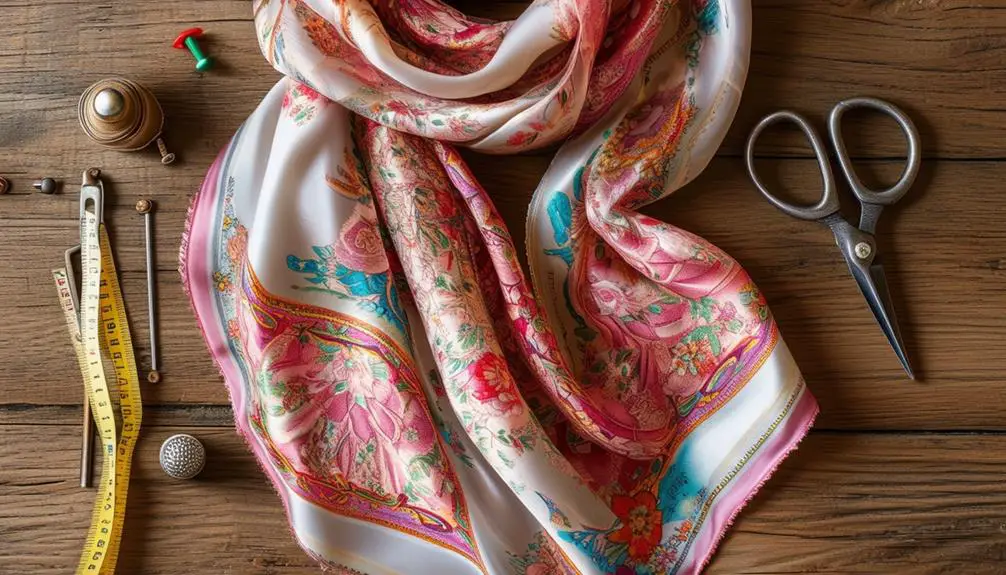

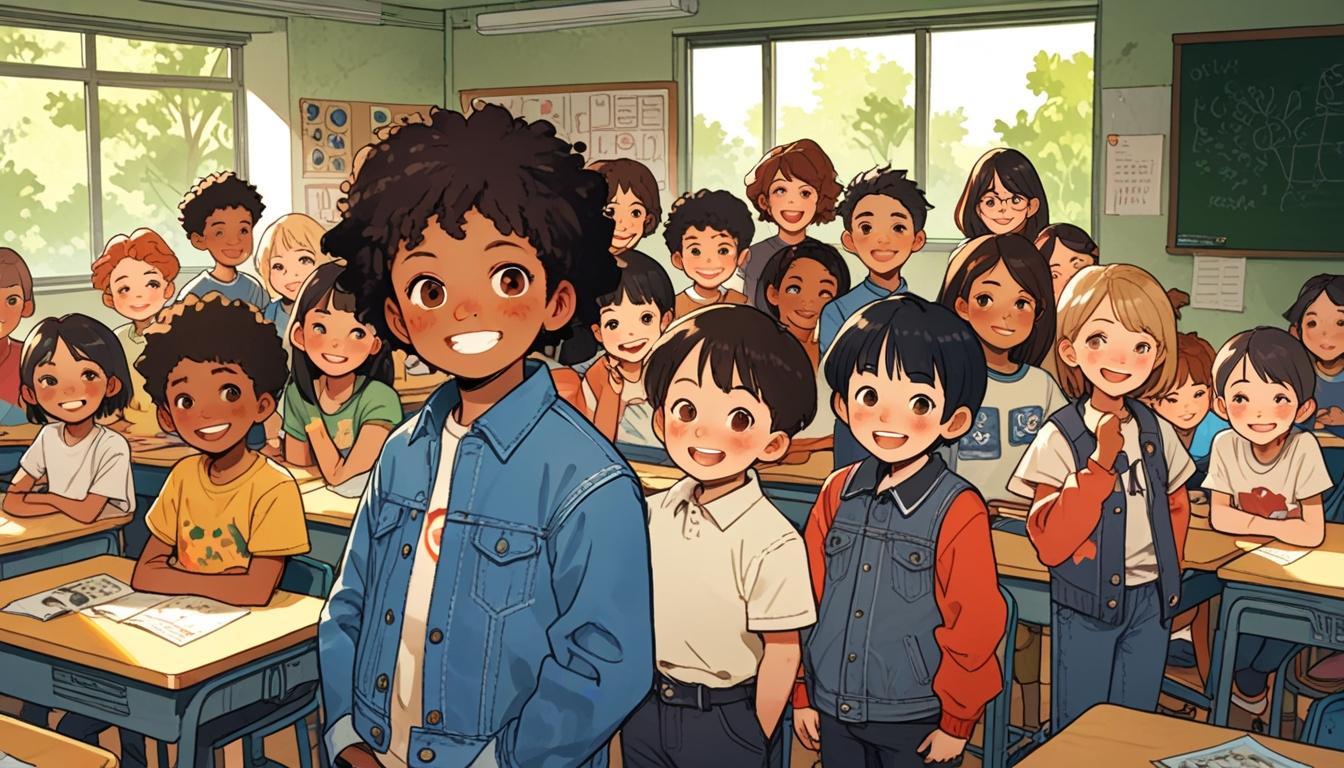
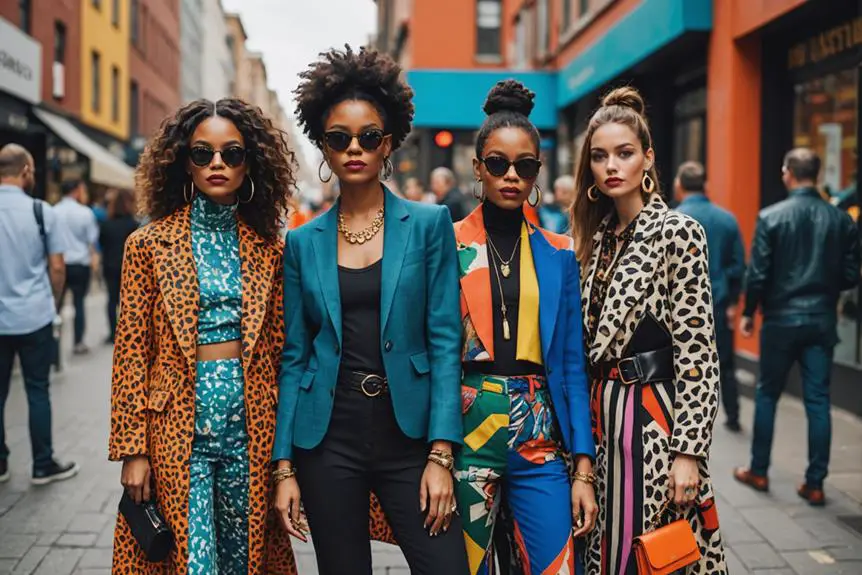

I don’t think the title of your article matches the content lol. Just kidding, mainly because I had some doubts after reading the article.
Your point of view caught my eye and was very interesting. Thanks. I have a question for you.
Your article helped me a lot, is there any more related content? Thanks!
Your article helped me a lot, is there any more related content? Thanks!
https://t.me/s/TgGo1WIN/9
??????????? Telegram ????? 1win Casin?. ?????o ? ?????? ?? 1???. ????????, ?????????? ??????? ???????????? ????? 1 win. ????????????? ? ??? ???, ??????? ???? ? ???? ???, ??????? ????? ????????? ???????? ? ??????? ?????? ?? ???????? ??????.
https://t.me/s/Official_1win_kanal/381
To tailor a vintage silk scarf, start by choosing one in good condition, such as a 20 x 20 inch neckerchief for versatility. Gather tools like sharp scissors, a sewing machine with a size 10 needle, and fine pins. Lay the scarf flat, mark cutting lines with tailor’s chalk, and cut carefully. For hems, consider a simple fold-over or hand-rolled finish for elegance. Experiment with different styling methods, like knotting it around your neck or bag. Don’t be afraid to explore creative ways to bring new life to your vintage scarf, transforming it into a fashionable and unique accessory.
This guide offers clear, step-by-step instructions for tailoring a vintage silk scarf, blending practical sewing tips with an appreciation for preserving timeless elegance. It highlights essential tools and techniques to handle delicate silk fabric with care, helping readers personalize scarves while maintaining their beauty and quality. Perfect for DIY enthusiasts and vintage lovers, the blog inspires creativity and craftsmanship, making the process both enjoyable and rewarding.
Creating your vintage silk scarf is simple and fun. Choose a good-quality scarf—something like a 20×20 inch square works well. Use sharp scissors, tailor’s chalk, and a sewing machine with a size 10 needle to get started. Cut carefully, and finish the edges with a fold-over hem or hand-rolled technique for a neat look. Once done, get creative—tie it around your neck, wrap it on a bag, or style it your way. Make it truly yours!
Hey! If you’re into vintage fashion, tailoring a silk scarf can be a great way to add a personal touch to your wardrobe. Start by choosing a scarf in good condition, then gather some tools like a sewing machine and sharp scissors. Mark the cutting lines and ensure precision with pins. For hems, try a simple fold-over finish or a hand-rolled hem for an elegant look. Make sure to choose fabrics like habotai or chiffon for ease of tailoring, and avoid any scarves with significant wear. Keep experimenting with different styles, and soon, you’ll have a beautiful custom piece!
This is a really helpful guide for anyone who loves vintage silk scarves! I like how you explained the tools and step-by-step process clearly, making it easy even for beginners. The tips on different hemming styles and fabric choices were very useful. I never knew scarves could be upcycled into so many creative things like tops or handbags — that’s inspiring! Also, the advice about pre-washing to avoid color bleeding is smart and something I would have missed. Thanks for sharing these great ideas and making tailoring vintage scarves feel fun and doable!
This is such a beautifully detailed guide. I love how you break down each step of tailoring a vintage silk scarf, from selecting the right fabric to understanding sizes and prepping tools. Your tips make even a delicate silk scarf feel manageable to work with, and the styling ideas are inspiring. Definitely bookmarking this for my next creative project can’t wait to try these techniques myself.
I really enjoyed reading this! The step-by-step guide is super helpful, especially the tips on choosing the right fabric and hemming techniques. I’ve always wanted to try tailoring my own vintage scarves, and this makes it feel much more doable. Can’t wait to give it a try and get creative with my scarves!
Tailoring a vintage silk scarf is such a fun and creative way to breathe new life into an old accessory! The step-by-step instructions make it sound simple yet stylish, from choosing the right fabric and cutting carefully to adding a fold-over hem or a hand-rolled edge for that extra touch of elegance. Experimenting with how to wear it, whether around your neck or as a bag accessory, like a great way to showcase your personal style. Plus, the tips on selecting a scarf that suits your vision really help you customize the project. This is definitely an enjoyable DIY that can result in a unique and chic piece!
To create a beautifully tailored vintage silk scarf, begin by choosing one in good condition, preferably around 20 x 20 inches for versatile styling. You’ll need sharp scissors, a sewing machine with a size 10 needle, and fine pins for precision. Lay the scarf flat and use tailor’s chalk to mark cutting lines, cutting carefully. For hems, you can opt for a simple fold-over finish or go for an elegant hand-rolled hem. Once completed, explore creative ways to style your scarf—wrap it around your neck or drape it on your bag. This process allows for endless possibilities, breathing new life into the scarf and adding your unique touch to its charm.